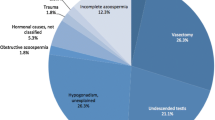Abstract
Purpose: To investigate the outcome of IVF following intracytoplasmic sperm injection (ICSI) from ejaculate, percutaneous epididymal sperm aspiration (PESA) and testicular sperm extraction (TESE), with subsequent blastocyst culture and single blastocyst transfer.
Methods: Single blastocyst transfer was performed after ejaculate ICSI (oligozoospermia) in 587 patients, TESE/PESA (azoospermia) in 31 patients, and standard IVF in 680 women.
Results: There were only minor differences in IVF characteristics between the standard IVF and the PESA-TESE couples. Couples where ejaculate ICSI were performed seemed to represent a slightly poorer prognostic group. A viable fetus after the 12th gestational week, i.e. ongoing pregnancy, was present in 41.4% after ICSI/ET, 51.6% after PESA-TESE/ET and in 40.4% after standard IVF/ET (no significant differences).
Conclusion: Single blastocyst transfer after ejaculate ICSI or after PESA/TESE appears to give similar results as conventional IVF blastocyst culture.
Similar content being viewed by others
References
Gerris JMR. Single embryo transfer and IVF/ICSI outcome: a balanced appraisal. Hum Reprod Update 2005;11:105–21.
ESHRE Campus Course Report. Prevention of twin pregnancies after IVF/ICSI by single embryo transfer. Hum Reprod 2001;16:790–800.
Hellberg D, Blennborn M, Nilsson S. Defining women who are prone to have twins in in vitro fertilization—a necessary step towards single embryo transfer. J Ass Reprod Gen 2005;22:109–16.
Gardner DK, Lane M. Culture and selection of viable blastocysts: a feasible proposition for IVF? Hum Reprod Update 1997;3:367–82.
Jansen RPS. Benefits and challenges brought by improved results from in vitro fertilization. Internal Med J 2005;35:108–17.
Blake DA, Proctor M, Johnson NP. The merits of blastocyst versus cleavage stage embryo transfer: a Cochrane review. Hum Reprod 2004;19:795–807.
Menezo Y, Barak Y. Comparison between day-2 embryos obtained either from ICSI or resulting from short insemination IVF:influence of maternal age. Hum Reprod 2000;15:1776–80.
Miller JE, Smith TT. The effect of intracytoplasmic sperm injection and semen parameters on blastocyst development in vitro. Hum Reprod 2001;16:918–24.
Wilson M, Hartke K, Kiehl M, Rodgers J, Brabec C, Lyles R. Integration of blastocyst transfer for all patients. Fertil Steril 2002;77:693–6.
Zollner U, Zollner K-P, Hartl G, Dietl J, Steck T. The use of a detailed zygote score after IVF/ICSI to obtain good quality blastocysts: the German experience. Hum Reprod 2002;17:1327–33.
Westphal LM, Hinckley MD, Behr B, Milki AA. Effect of ICSI on subsequent blastocyst development and pregnancy rates. J Ass Reprod Gen 2003;20:113–6.
Van Landuyt L, De Vos A, Joris H, Verheyen G, Devroey P, Van Steirteghem A. Blastocyst formation in in vitro fertilization versus intracytoplasmic sperm injection cycles: influence of the fertilization procedure. Fertil Steril 2005;83:1397–1403.
Waldenström U, Hellberg D, Nilsson S. Low-dose aspirin in a short regimen as standard treatment in in vitro fertilization—a randomized, prospective study. Fertil Steril 2004;81;1560–4.
Silber SJ, Nagy ZP, Liu J, Godoy H, Devroey P, Van Steirteghem AC. Conventional in vitro fertilization versus intracytoplasmic sperm injection of patients requiring microsurgical sperm aspiration. Hum Reprod 1994;9:1705–9.
Pasqualotto FF, Rossi-Ferragut LM, Rocha CC, Iaconelli A, Borges E. Outcome of in vitro fertilization and intracytoplasmic injection of epididymal and testicular sperm obtained from patients with obstructive and nonobstructive azoospermia. J Urol 2002;167:1753–6.
Levine LA, Dimitriou RJ, Fakouri B. Testicular and epididymal percuntaneous sperm aspiration in men with either obstructive or nonobstructive azoospermia. Urology 2003;62:328–32.
Park Y-S, Lee S-H, Song SJ, Jun JH, Koong MK, Seo JT. Influence of motility on the outcome of in vitro fertilization/intracytoplasmic sperm injection with fresh vs. frozen testicular sperm from men with obstructive azoospermia. Fertil Steril 2003;80:526–30.
Balaban B, Urman B, Isiklar A, Alatas C, Mercan R, Aksoy S, Nuhoglu A. Blastocyst transfer following intracytoplasmic injection of ejaculated, epididymal or testicular spermatozoa. Hum Reprod 2001;16:125–9.
Virant-Klun I, Tomazevic T, Zorn B, Bacer-Kermavner L, Mivsek J, Meden-Vrtovec H. Blastocyst formation—good indicator of clinical results after ICSI with testicular spermatozoa. Hum Reprod 2003;18:1070–6.
Nilsson S, Waldenström U, Engström A-B, Hellberg D. Promising results with 306 single blastocyst transfers. Fertil Steril 2005;83:1849–51.
Hennman M, Catt JW, Wood T, Bowman MC, de Boer KA, Jansen RPS. Elective transfer of single fresh blastocysts and later transfer of cryostored blastocysts reduces the twin pregnancy rate and can improve the in vitro fertilization live birth rate in younger women. Fertil Steril 2005;84:1620–7.
Papanikolaou EG, Camus M, Kolibianakis EM, Van Landuyt L, Van Steirteghem A, Devroey. In vitro fertilization with single blastocyst-stage versus single cleavage-stage embryos. N Engl J Med 2006;354:1139–46.
Barri PN, Vendrell JM, Martinez F, Coroleu B, Aran B, Veiga A. Influence of spermatogenic profile and meiotic abnormalities on reproductive outcome of infertile patients. Reprod Biomed Online 2005;10:735–9.
Levron J, Aviram-Goldring A, Madgar I, Raviv G, Barkari G, Dor J. Studies on sperm chromosomes in patients with severe male factor infertility undergoing assisted reproductive technology treatment. Mol Cellular Endocrinol 2001;183:S23–S28.
Silber S, Escudero T, Lenahan K, Abdelhadi I, Kilani Z, Munne S. Chromosomal abnormalities in embryos derived from testicular sperm extraction. Fertil Steril 2003;79:30–8.
Calogero AE, Burrello N, De Palma A, Barone N, DAgata R, Vicari E. Sperm aneuploidy in infertile men. Reprod Med Online 2003;6:310–7.
Janny L, Menezo YJR. Evidence for a strong paternal effect on human preimplantation embryo development and blastocyst formation. Mol Reprod Dev 1994;38:36–42.
Hardarson T, Caisander G, Sjögren A, Hanson C, Hamberger L, Lundin K. A morphological and chromosomal study of blastocysts developing from morphologically suboptimal human pre-embryos compared with control blastocysts. Hum Reprod 2003;18:399–407.
Banerjee S, Lamond S, McMahon A, Campbell S, Nargund G. Dose blastocyst culture eliminate paternal chromosomal defects and select good embryos? Hum Reprod 2000;15:2455–9.
Author information
Authors and Affiliations
Corresponding author
Rights and permissions
About this article
Cite this article
Nilsson, S., Waldenström, U., Engström, AB. et al. Single blastocyst transfer after ICSI from ejaculate spermatozoa, percutaneous epididymal sperm aspiration (PESA) or testicular sperm extraction (TESE). J Assist Reprod Genet 24, 167–171 (2007). https://doi.org/10.1007/s10815-006-9091-8
Received:
Accepted:
Published:
Issue Date:
DOI: https://doi.org/10.1007/s10815-006-9091-8




